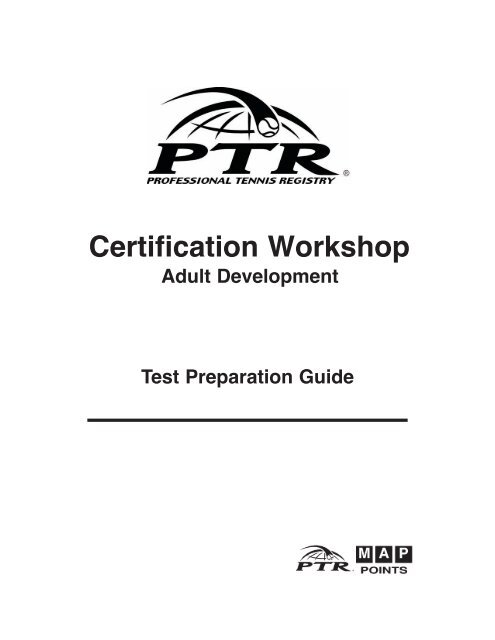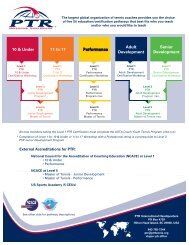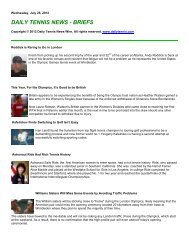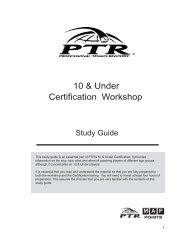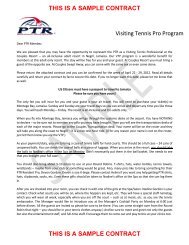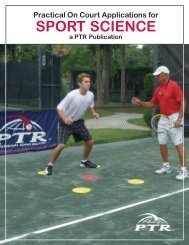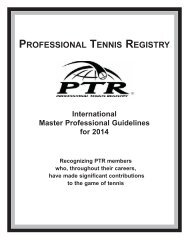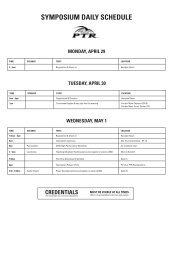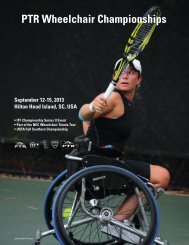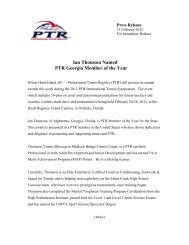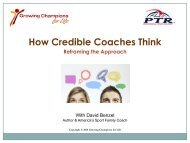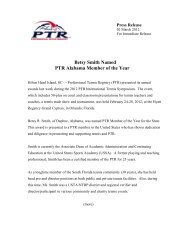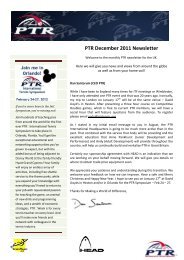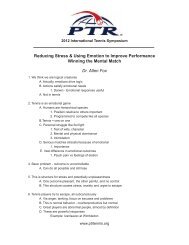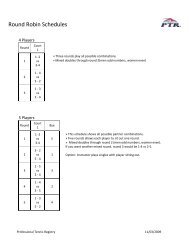Certification Workshop - Professional Tennis Registry
Certification Workshop - Professional Tennis Registry
Certification Workshop - Professional Tennis Registry
You also want an ePaper? Increase the reach of your titles
YUMPU automatically turns print PDFs into web optimized ePapers that Google loves.
<strong>Certification</strong> <strong>Workshop</strong><br />
Adult Development<br />
Test Preparation Guide
CONTENTS<br />
Welcome 1<br />
Serve<br />
Outline for Group Lesson 2<br />
Errors & Corrections 3<br />
Forehand<br />
Outline for Group Lesson 4<br />
Errors & Corrections 5<br />
Backhand<br />
Outline for Group Lesson 6<br />
Errors & Corrections 7<br />
Volley Progressions 8<br />
Tactical Priorities of the Serve 9<br />
Spin Serve Progressions 9<br />
Overhead Progressions 11<br />
Drop Shot Progressions 11<br />
Forehand Approach Shot (Slice) Progressions 12<br />
Backhand Approach Shot (Slice) Progressions 13<br />
Topspin Lob Progressions 14<br />
Half Volley Progressions 15<br />
Instant <strong>Tennis</strong> Progressions 16<br />
10 Minute Warm Up 18<br />
Grips 20<br />
Glossary of Terms 21<br />
General Teaching Considerations 22<br />
Written Test Preparation 23<br />
Sample Test Questions 24<br />
Copyright © 2010<br />
<strong>Professional</strong> <strong>Tennis</strong> <strong>Registry</strong><br />
All rights reserved.<br />
Reproduction in whole or in part is not permitted without written consent of <strong>Professional</strong> <strong>Tennis</strong> <strong>Registry</strong>.
Welcome to PTR<br />
Adult Development<br />
<strong>Certification</strong> <strong>Workshop</strong><br />
The <strong>Certification</strong> <strong>Workshop</strong> - Adult Development - is a presentation and an explanation<br />
of a fundamentally sound method of teaching tennis to beginning players. Upon completion<br />
of the workshop, you should have a good foundation for instructing tennis. If<br />
you are taking the certification exam at the conclusion of the workshop, the material<br />
presented will greatly increase your ability to perform well on the test.<br />
The primary emphasis of the workshop will be on the teaching of the serve, forehand<br />
and backhand to a group of students. The progressions used in the teaching of the<br />
other specialty shots will also be demonstrated. Many terms used in the teaching of<br />
tennis will be incorporated into the workshop by your workshop leader. Pay close<br />
attention to the organization of the lesson, its division into three distinct parts, the use<br />
of corrective techniques, the importance of safety and the purpose of demonstrations.<br />
There is a tremendous amount of information to be presented during the workshop,<br />
and it is important for your workshop leader to keep the day moving. Please feel free<br />
however, to direct questions to your workshop leader during pauses or breaks in the<br />
activities. PTR workshop leaders are experienced teachers and coaches, and have<br />
been trained specifically to conduct the workshop.<br />
Finally, remember that the other attendees in the workshop are likely to be from considerably<br />
different backgrounds and are attending for many different reasons.<br />
Participants often include full time teaching professionals, high school coaches, camp<br />
counselors, college coaches, recreational instructors, retired teachers, or possibly just<br />
interested parents of junior players.<br />
Teaching tennis is a skill to be developed throughout a lifetime. It is important to<br />
always continue to improve ourselves as well as our students, to learn from mistakes<br />
and to actively pursue more knowledge to become a better instructor.<br />
Enjoy the workshop experience and best of luck to those of you who will be taking the<br />
certification exam.<br />
Dan Santorum<br />
PTR CEO & Executive Director<br />
PTR ADULT DEVELOPMENT CERTIFICATION WORKSHOP TEST PREPARATION GUIDE 1
SERVE - Outline for Group Lesson<br />
Introduction<br />
• Greet students & learn names<br />
• Briefly describe lesson/goal of lesson<br />
• Have students demonstrate their serves<br />
• Give positive comment & identify ONE error (stroke evaluation)<br />
• Demonstrate serve (2-3 times)<br />
Part 1 - Teaching the Stroke<br />
1. Line up students on baseline and demonstrate components with students shadowing<br />
a. Stance<br />
b. Grip<br />
c. Pronation<br />
d. (Drop behind back) swing up on edge<br />
e. (Drop behind back) swing up with pronation<br />
f. Weight transfer<br />
---Move students to net ---<br />
g. Point of Contact*<br />
h. Add follow through*<br />
i. Add backswing (broken serve)*<br />
j. Rhythm - no toss<br />
k. Rhythm - with toss and catch<br />
l. Complete serve*<br />
2. Students demonstrate serves (half-court or closer)<br />
* indicates a step where the ball is struck<br />
Part 2 - Individual Help<br />
1. Organize for Individual Help<br />
a. Line students up halfway between service line and net<br />
b. Instructor works individually with a student on end<br />
c. Instructor rotates students until all receive individual help<br />
2. Attention must be paid to all students using names and feedback<br />
continuously<br />
3. Students demonstrate serves (half-court or closer)<br />
Part 3 - Practice<br />
1. Organize for Practice<br />
a. Have students line up five or six balls from the net to the baseline<br />
b. All students begin with ball closest to net<br />
c. Demonstrate and explain practice procedure (hitting up on ball)<br />
2. Students progressively serve balls moving from net to the baseline<br />
3. Have balls available for students who miss their serves into the net<br />
4. Assemble students in deuce alley near service line and demo the tactical<br />
priorities<br />
5. Students demonstrate serves (half-court or closer)<br />
2 PTR ADULT DEVELOPMENT CERTIFICATION WORKSHOP TEST PREPARATION GUIDE
Wrap up<br />
• Instructor brings students together in a group<br />
• Review individual errors in a positive manner<br />
• Give practice suggestions to students<br />
• Provide incentive to return for future lessons<br />
• Thank the students<br />
Errors & Corrections<br />
Additional errors and corrections are included in the PTR Preparation for <strong>Certification</strong> DVD or<br />
PTR Instructor’s Manual.<br />
Error<br />
Front foot slides forward<br />
Before contact (foot fault)<br />
Incorrect grip/changes in grip<br />
Loss of balance<br />
Improper point of contact<br />
Correction<br />
Place an object (ball, racquet) in front of the front<br />
foot.<br />
Place a pencil between the index knuckle and the<br />
racquet (pencil rests at 45-degrees).<br />
Have student serve with feet together facing forward.<br />
Rarely teach how to toss the ball. Always stress<br />
point of contact.<br />
Tap the ball at the point of contact at the fence.<br />
Elbow drops<br />
Muscling the ball<br />
No hip rotation<br />
Have student toss the ball up and rebound off the<br />
top of the elbow.<br />
Serve holding the racquet with two fingers.<br />
Belly button facing the net.<br />
Back heel off the ground.<br />
Knees dip before toss<br />
Have the student serve with legs locked.<br />
Have the student serve with one knee on the ground.<br />
Pushing the ball forward<br />
(no pronation)<br />
Quick toss<br />
Quick backswing<br />
Tap the ball against the fence. The tip of the racquet<br />
will meet the fence first.<br />
Leave tossing arm in the air for two counts after<br />
releasing the ball.<br />
Imagine you are taking racquet back under water.<br />
PTR ADULT DEVELOPMENT CERTIFICATION WORKSHOP TEST PREPARATION GUIDE 3
FOREHAND - Outline for Group Lesson<br />
Introduction<br />
• Greet students & learn names<br />
• Briefly describe lesson/goal of lesson<br />
• Have students demonstrate their forehands<br />
• Give positive comment & identify ONE error (stroke evaluation)<br />
• Demonstrate forehand (2-3 times)<br />
Part I - Teaching the Stroke<br />
1. Line up students on baseline and demonstrate components with students shadowing<br />
a. stance<br />
b. grip<br />
c. turn & pivot (shoulder turn)<br />
d. racquet back & down<br />
e. adjusting steps<br />
f. point of contact<br />
g. follow through<br />
2. Students moved to net and learn/practice self-start<br />
3. Stroke progressions introduced<br />
a. hit from point of contact<br />
b. hit from backswing position<br />
c. hit from shoulder turn position<br />
4. Students demonstrate forehands (half-court)<br />
Part 2 - Individual Help<br />
1. Organize for Individual Help<br />
a. One student becomes ‘assistant coach’ (feeder) and feeds to two students<br />
b. Instructor works individually with one student on same error identified in<br />
Introduction<br />
2. Instructor rotates (clockwise) students until all receive individual help<br />
3. Attention must be paid to all students using names and feedback continuously<br />
4. Students demonstrate forehands (half-court)<br />
Part 3 - Practice<br />
1. Organize for Practice (emphasis on footwork and point of contact)<br />
a. Position students in two lines of two for point of contact practice. Instructor<br />
alternates feeds to each line and students rotate positions.<br />
b. Pair up students across from each other for rally practice. Instructor moves<br />
about court with comments and using students’ names.<br />
2. Students demonstrate forehands (half-court)<br />
4 PTR ADULT DEVELOPMENT CERTIFICATION WORKSHOP TEST PREPARATION GUIDE
Wrap up<br />
• Instructor brings students together in a group<br />
• Review individual errors in a positive manner<br />
• Give practice suggestions to students<br />
• Provide incentive to return for future lessons<br />
• Thank the students<br />
Errors & Corrections<br />
Additional errors and corrections are included in the PTR Preparation for <strong>Certification</strong> DVD or<br />
PTR Instructor’s Manual.<br />
Error<br />
Improper point of contact<br />
Wristy at point of contact<br />
Slicing the ball<br />
(cannot hit topspin)<br />
Short follow through<br />
Steps in with wrong foot<br />
Hits off back foot<br />
Wrist break on backswing<br />
(excessive backswing)<br />
Scoops or parallel backswing<br />
Correction<br />
Have student catch the ball at the point of contact<br />
on the strings.<br />
Hold racquet halfway. May also place ball between<br />
racquet and forearm.<br />
Have student touch the racquet to the ground<br />
before swinging forward.<br />
Have student catch the racquet with the left hand.<br />
Step on a coin or foot pedal.<br />
From behind the student, throw the ball out in front.<br />
The student stands beside the net with the body<br />
on one side of the net and the racquet on the other.<br />
The net will make sure that there is no excessive<br />
backswing.<br />
Swinging over, then under racquet. Have student<br />
leave dominant hand on racquet longer.<br />
Have the student trace your racquet frame with<br />
theirs.<br />
Not enough shoulder turn on<br />
backswing<br />
Have student leave non-dominant hand on racquet<br />
longer.<br />
Put a racquet in both hands. Keep them together<br />
during the shoulder turn.<br />
Leading with elbow<br />
Have student place ball under upper arm between<br />
arm and body. Ball should not drop out until<br />
racquet swings forward.<br />
PTR ADULT DEVELOPMENT CERTIFICATION WORKSHOP TEST PREPARATION GUIDE 5
BACKHAND - Outline for Group Lesson<br />
Introduction<br />
• Greet students & learn names<br />
• Briefly describe lesson/goal of lesson<br />
• Have students demonstrate their backhands<br />
• Give positive comment & identify ONE error (stroke evaluation)<br />
• Demonstrate backhand (2-3 times with reference to two-handed backhand as well)<br />
Part 1 - Teaching the stroke - Basic progressions<br />
1. Line up students on baseline and demonstrate components with students shadowing<br />
a. stance<br />
b. grip<br />
c. turn & pivot (shoulder turn)<br />
d. racquet back & down<br />
e. adjusting steps<br />
f. point of contact<br />
g. follow through<br />
2. Students moved to net and learn/practice self-start<br />
3. Stroke progressions introduced<br />
a. hit from point of contact<br />
b. hit from backswing position<br />
c. hit from shoulder turn position<br />
4. Students demonstrate backhands (half-court)<br />
Part 2 - Individual Help<br />
1. Organize for Individual Help<br />
a. One student becomes ‘assistant coach’ (feeder) and feeds to two students<br />
b. Instructor works individually with one student on same error identified in<br />
Introduction<br />
2. Instructor rotates (counterclockwise) students until all receive individual help<br />
3. Attention must be paid to all students using names and feedback continuously<br />
4. Students demonstrate backhands (half-court)<br />
Part 3 - Practice<br />
1. Organize for Practice (emphasis on footwork and point of contact)<br />
a. Position students in two lines of two for point of contact practice. Instructor<br />
alternates feeds to each line and students rotate positions.<br />
b. Pair up students across from each other for rally practice. Instructor moves<br />
about court with comments and using students’ names.<br />
2. Students demonstrate backhands (half-court)<br />
6 PTR ADULT DEVELOPMENT CERTIFICATION WORKSHOP TEST PREPARATION GUIDE
Wrap up<br />
• Instructor brings students together in a group<br />
• Review individual errors in a positive manner<br />
• Give practice suggestions to students<br />
• Provide incentive to return for future lessons<br />
• Thank the students<br />
Errors & Corrections<br />
Additional errors and corrections are included in the PTR Preparation for <strong>Certification</strong> DVD or<br />
PTR Instructor’s Manual.<br />
Error (One-handed)<br />
Incorrect grip<br />
Leading with elbow<br />
Wrist break on backswing<br />
Excessive hip and shoulder<br />
rotation<br />
Hits off back foot<br />
Correction<br />
Place pencil between forefinger and grip.<br />
Sandwich a ball against the body, under the arm<br />
above the elbow.<br />
Stand student beside the net with body on one side<br />
and racquet on the other. Net will prevent<br />
excessive backswing.<br />
Hold a ball hopper with non-playing hand.<br />
Student steps on a coin placed in front of him/her.<br />
Feed the student short balls<br />
Improper point of contact<br />
Racquet rolls on follow through<br />
Toss the student a few balls and ask him/her to stop<br />
at the point of contact.<br />
Have the student stand with back to fence, stopping<br />
follow through.<br />
Have the student stop at the point of contact and<br />
then add the follow through.<br />
Error (Two-handed)<br />
Left hand (wrist) covers ball<br />
Racquet too far back on backswing<br />
Correction<br />
Push against instructor’s racquet through swing<br />
(follow through).<br />
Use net as a barrier to prevent extreme backswing.<br />
PTR ADULT DEVELOPMENT CERTIFICATION WORKSHOP TEST PREPARATION GUIDE 7
VOLLEY PROGRESSIONS<br />
The volley is considered the easiest to learn of all the strokes in tennis because of its simplicity.<br />
The student takes a relaxed stance facing the net with feet about shoulder width apart and knees<br />
slightly flexed. The volley is executed by having your student simply set his/her racquet in order<br />
to “block the ball”. There is little or no backswing. As students become more advanced, they will<br />
incorporate a quick shoulder turn, an abbreviated backswing and a short follow through.<br />
FOREHAND VOLLEY<br />
1. Block ball with hand The student simply blocks or catches the ball with his/her hand.<br />
Note: For Steps 2, 3 & 4, the angle of the racquet is facing the opposite foot, or<br />
roughly at a 45-degree angle.<br />
2. Big hand<br />
3. Hand halfway<br />
4. Full grip<br />
The student holds the racquet at the throat with three fingers on<br />
the strings. The thumb and pinkie finger grasp the sides of the<br />
racquet. The ball is tossed underhand by the partner and the<br />
student blocks the ball on the strings.<br />
The student slides the hand halfway down the racquet. Using<br />
an eastern forehand grip, the student blocks the ball on the<br />
strings.<br />
Slide the hand all the way down the racquet. Using an eastern<br />
forehand grip, block the balls on the strings.<br />
BACKHAND VOLLEY<br />
The backhand volley uses the same progressions as the forehand volley. One exception is that<br />
the grip used is an eastern backhand. Also, in Step 1 (Block ball with hand), the student should<br />
extend the arm out and to the far left side of the face. Make a “thumbs up” sign and then block<br />
the ball with the fist.<br />
Note: The volley is taught using an eastern forehand and backhand grip to provide the<br />
student with more initial success. Eventually, with more muscle strength and<br />
feel, a continental grip will be used.<br />
8 PTR ADULT DEVELOPMENT CERTIFICATION WORKSHOP TEST PREPARATION GUIDE
TACTICAL PRIORITIES OF THE SERVE<br />
Discuss the tactical priorities of the serve. This is an excellent context for introducing the spin<br />
serve. You should be able to proficiently demonstrate the five tactical priorities of the serve, which<br />
include the topspin serve. Tactical priorities for the serve are:<br />
1. Consistency: Get the ball in the correct service court.<br />
2. Placement or Direction: Serve to the forehand or backhand side, or<br />
down the middle.<br />
3. Depth: Being able to hit the ball deep or short.<br />
4. Spin: Slice or topspin.<br />
5. Power: A ball hit with velocity.<br />
Most people don’t follow these tactical priorities. Instead, they try to hit the ball as hard as they can,<br />
with minimal control. To ensure that your students develop a controlled serve, ask them to serve the<br />
ball slowly over the net so it will bounce twice before crossing the baseline. As the stroke becomes<br />
more fluid and relaxed, the racquet head speed will naturally increase. This will prepare the player<br />
to learn slice and spin. When discussing spin, show your students where slice is most effective<br />
(wide - where it pulls your opponent off the court; or into the body - where it jams your opponent).<br />
SPIN SERVE PROGRESSIONS<br />
The spin serve is a stroke that should be taught to people of intermediate and advanced levels.<br />
Only players who can generate reasonable racquet head speed can benefit from a spin or slice<br />
serve.<br />
Organize your students in a semi-circle. Grip the racquet halfway up the handle, so they have<br />
more control.<br />
Note: The students will keep a half grip until the final progression.<br />
Explain the motion of the racquet by using the example of a clock face. For a flat serve, the point<br />
of contact would be in the center, or where the hands meet on a clock face. On the slice serve,<br />
the racquet travels in a direction toward 3 o’clock. For the spin serve, the racquet travels from<br />
7 o’clock toward 1 o’clock. Students will practice each step after your demonstration.<br />
1. Creating spin<br />
2. Demo spin<br />
Show your students how to bypass the ball at 6 o’clock. The<br />
racquet moves back and forth (right to left, toward the body)<br />
underneath the ball to produce underspin. This exercise should<br />
be done with the ball staying on the racquet. After a few<br />
bypasses, let the ball drop to the ground and look at the spin<br />
that is produced. Have the students practice this step.<br />
Bring the students close to the net. Rest the racquet behind<br />
your shoulder and demonstrate the following. With a short toss,<br />
no higher than your chest, bypass the ball at 6 o’clock. You<br />
should contact the ball at waist level. The ball will travel over<br />
the net with underspin.<br />
PTR ADULT DEVELOPMENT CERTIFICATION WORKSHOP TEST PREPARATION GUIDE 9
3. Demo slice<br />
To show slice, rest the racquet behind your shoulder and swing<br />
the racquet up, bypassing the ball at 3 o’clock. The racquet<br />
moves to the ball at a 45-degree angle. There is no follow through.<br />
Note: Remind the students not to “cup” the ball or try to “come around the ball”.<br />
Everyone should still be holding the racquet halfway up the shaft. Most<br />
importantly, it is a short, abbreviated stroke with no follow through.<br />
4. Demo topspin<br />
5. Demo<br />
follow through<br />
From the slice motion, we move to topspin. Rest the racquet<br />
behind your shoulder and move the racquet from 7 o’clock to a<br />
1 o’clock position. The follow through is abbreviated, with the<br />
racquet handle finishing on the outside of the forearm. By correctly<br />
hitting up on the ball, you will create some topspin. Only the<br />
forearm rotates as the wrist rolls with the butt of the racquet.<br />
The next progression is to demonstrate following through behind<br />
your back. At the finish, the back of your hand should be resting on<br />
the small of your back. This will produce greater topspin on the ball.<br />
Caution: Steps 5 & 6 should be done at 1/2 pace - slow motion, because they are<br />
not natural motions. Students who have injured shoulders or elbows may<br />
skip these steps.<br />
6. Add backswing<br />
7. Normal follow through<br />
8. Emphasize<br />
hitting up<br />
The next step is to start with the racquet and ball together and use<br />
a rhythmic backswing and ball toss. (Remember we still have not<br />
moved the grip to the end of the handle.) Again, complete the<br />
stroke by slowly finishing behind the back.<br />
As a next step, demonstrate the topspin serve with a normal follow<br />
through (on the left side of the body).<br />
Finally, have your students hold the racquet full length and move<br />
to the outside of the fence or backdrop. Stand at arm’s length away<br />
from the fence or backdrop and slowly serve over the barrier.<br />
Note: Pronation of the forearm is used in flat, slice and topspin serves. However,<br />
pronation naturally occurs at different times for each type of serve.<br />
Safety Tip: Do not serve in front of a fence pole or any solid object where the ball<br />
might ricochet.<br />
10 PTR ADULT DEVELOPMENT CERTIFICATION WORKSHOP TEST PREPARATION GUIDE
OVERHEAD PROGRESSIONS<br />
Demonstrate the overhead and each progression. Separate your students into pairs and go<br />
through the following progressions.<br />
1. Ball catch<br />
2. Ball catch, serve<br />
3. No catch, overhead<br />
with bounce<br />
4. Overhead without<br />
bounce<br />
From the baseline, one player feeds a high lob. His/her partner<br />
stands sideways in a serve stance, racquet on shoulder and left<br />
hand extended toward the sky. Player adjusts feet and positions<br />
himself to be able to catch the ball, after the bounce, in his left hand<br />
above the head.<br />
Player now catches the ball after the bounce, makes a serve toss<br />
and hits the ball over the net. Player should make a complete<br />
follow through.<br />
Player now adjusts feet to be able to play an overhead without<br />
catching the ball. Left hand is still extended toward the descending<br />
ball. Player acts as if to prepare to catch the ball, but instead<br />
plays the overhead.<br />
Same as Step 3, except player now hits overhead out of the air.<br />
DROP SHOT PROGRESSIONS<br />
The drop shot is very similar to the volley in that the ball is blocked in order to play the stroke. There<br />
are a number of ways to hit a drop shot. Most of the pros tend to use a very relaxed wrist or they<br />
use extreme underspin. This, however, takes a great amount of skill and timing. The simplest way<br />
to hit a drop shot is to block the ball on the rise. A drop shot is most effective when it is played from<br />
inside the service line.<br />
Demonstrate the drop shot and each progression. Then separate your students into pairs and, using<br />
eastern grips, do the following progressions.<br />
1. Volley<br />
2. Drop shot<br />
Both you and your partner move back to the service line. Have your<br />
partner feed you some volleys. Get the feel of gently blocking the<br />
ball over the net.<br />
The partner feeds a “baby serve” (racquet on the shoulder and<br />
gently reach up and contact the ball - no follow through) and player<br />
hits a drop shot (block) where the highest point of the ball’s<br />
trajectory (apex) is on the player’s side of the net.<br />
Note: The backhand drop shot uses the same progressions as the forehand. It is<br />
biomechanically easier to hit than the forehand because you lead with your<br />
hitting shoulder, which is out in front.<br />
PTR ADULT DEVELOPMENT CERTIFICATION WORKSHOP TEST PREPARATION GUIDE 11
FOREHAND APPROACH SHOT (SLICE) PROGRESSIONS<br />
Demonstrate the slice approach shot and show how it differs from the usual groundstroke. The ball<br />
is hit as the player is moving to the net. This is called “dynamic balance”. The ball is hit with a<br />
semi-open stance off the right foot, while the player is in stride. Most players have greater success<br />
using a continental grip. A continental grip opens the face of the racquet, thus making the slice<br />
easier. Separate into pairs and do the following progressions.<br />
1. Toss, step right, hit,<br />
step left<br />
2. Feed, step right, hit,<br />
step left<br />
3. Add more footwork<br />
4. Dynamic<br />
approach shot<br />
Both students are at the service line. The hitter tosses the ball in<br />
front and steps with the right foot a split second before contacting<br />
the ball. The hitter then steps with the left foot.<br />
With both students at the service line, the feeder drop-feeds a<br />
ball to the hitter. The hitter pushes off the right foot a split second<br />
before contacting the ball. The hitter then steps with the left foot.<br />
Repeat Step 2. After hitting the stroke, continue to the net and<br />
use a split step.<br />
To make the stroke more dynamic, the hitter goes back to the<br />
baseline and hits the forehand approach shot off of a short feed.<br />
The hitter continues toward the net, split steps and blocks a volley.<br />
Note: On the follow through, the racquet face points toward the direction of the ball.<br />
12 PTR ADULT DEVELOPMENT CERTIFICATION WORKSHOP TEST PREPARATION GUIDE
BACKHAND APPROACH SHOT (SLICE) PROGRESSIONS<br />
The one-handed backhand approach shot is also hit down the line or down the middle. The key<br />
to this shot is mastering the footwork that enables the hitter to keep the body sideways to the net<br />
while hitting the shot. The footwork movement used is called a carioca step, where the left foot<br />
crosses behind the right foot to keep the body sideways. The carioca step is dynamic, since the<br />
player moves toward the net while staying sideways. Most players have greater success using a<br />
continental grip.<br />
Demonstrate the backhand approach shot and each progression. Then separate into pairs and<br />
go through the following progressions.<br />
1. Lock and block<br />
2. Lock and extend<br />
3. Lock and hit<br />
with footwork<br />
4. Dynamic<br />
approach shot<br />
With both players on the service line, the feeder drop-feeds a ball<br />
to the hitter. The hitter plays a drop shot (block) while at the<br />
same time sliding the left foot up behind the right foot, locking it<br />
ahead of the right foot.<br />
Same as the first step, except that the follow through is extended.<br />
Both arms move in opposite directions. The left foot is once<br />
again locked ahead of the right foot.<br />
Repeat Step 2, timing your carioca step and hitting in the same<br />
movement. After the stroke, continue to the net and add a<br />
split step.<br />
The hitter moves to the baseline and moves in on a short ball hit<br />
by the feeder. The hitter completes the same sequence of<br />
footwork. but this time without a pause, then sets up for the volley.<br />
Note: The backhand approach shot can also be hit by just leaving the ground while<br />
running sideways toward the net, then kicking your feet together.<br />
PTR ADULT DEVELOPMENT CERTIFICATION WORKSHOP TEST PREPARATION GUIDE 13
TOPSPIN LOB PROGRESSIONS<br />
The topspin lob has become a very popular shot in recent years. When executed properly, it<br />
leaves an opponent virtually helpless. However, since the topspin lob is not a particularly easy<br />
shot to hit, it is taught to individuals with intermediate and advanced skill levels.<br />
Demonstrate the forehand topspin lob and each progression. Then separate into pairs and do<br />
the following progressions.<br />
1. Sandwich<br />
the ball<br />
2. Spin on edge<br />
3. Open<br />
racquet face<br />
The ball is sandwiched between the net cord and the racquet.<br />
The student lifts the racquet straight up and over the right<br />
shoulder to produce excessive spin on the ball as the racquet<br />
travels sharply upward. The hitter’s partner retrieves the ball<br />
and places it back on the net for another attempt.<br />
The hitter takes three steps back. With the racquet head on<br />
edge and placed lower than the height of the net, the hitter<br />
drops the ball and swiftly swings straight up and over the right<br />
shoulder. This will put a heavy spin on the ball.<br />
The hitter moves back to the service line. The partner stays<br />
at the net with his/her racquet held up in the sky to show the<br />
necessary clearance for the topspin lob. The hitter turns<br />
sideways and opens up the racquet face to 45-degrees.<br />
The hitter drops the ball and takes a semi-circular backswing,<br />
then hits through the ball with a slightly open racquet face - just<br />
out in front of the left leg. The follow through over the right<br />
shoulder imparts heavy topspin. The ball should clear the<br />
partner’s racquet and land behind the imaginary line halfway<br />
between the service and baselines.<br />
4. Hit off<br />
partner’s feed<br />
The partner volley-feeds a ball to the hitter and immediately<br />
extends his/her racquet up in the air. The hitter adjusts the feet<br />
and, with a semi-circular backswing, hits up and through the<br />
ball. The ball should clear the partner’s racquet and land<br />
behind the imaginary line between the service and baselines.<br />
At this point, the feeders and hitters switch.<br />
14 PTR ADULT DEVELOPMENT CERTIFICATION WORKSHOP TEST PREPARATION GUIDE
HALF VOLLEY PROGRESSIONS<br />
In the half volley, the player contacts the ball immediately after it bounces. As a result, the half<br />
volley is mostly a neutral or defensive shot. As in the approach shot, the half volley is typically<br />
placed down the line or down the middle and deep, in a effort to cut down an opponent’s angles<br />
for a passing shot. One of the keys to this shot is bending at the knees rather than at the waist,<br />
to get down to the ball. As in the topspin lob and other speciality shots, the half volley is a more<br />
advanced stroke and should be taught to players who have developed a reasonable amount of<br />
ball skill.<br />
FOREHAND HALF VOLLEY<br />
Demonstrate the half volley and the following progressions. The grip used is an eastern<br />
forehand. Then separate into pairs and go through the following progressions. Instruct players<br />
to use a half volley feed to their partners for each progression.<br />
1. Bounce/block<br />
with hand<br />
With both students on the service line, the partner feeds a ball<br />
directly at the hitter’s feet.<br />
The hitter bends at the knees and either catches the ball or blocks<br />
the ball with his/her hand immediately after the ball bounces.<br />
2. Bounce/block<br />
with racquet<br />
With both students on the service line, the partner feeds a ball<br />
directly at the hitter’s feet.<br />
The hitter bends at the knees and blocks the ball with the racquet on<br />
edge near the ground. The timing is a one-two beat, bounce-block.<br />
3. Bounce/extend<br />
The ball is fed at the hitter’s feet and the hitter contacts the ball in<br />
front of the left leg. The face of the racquet follows through in the<br />
direction of the ball.<br />
BACKHAND HALF VOLLEY<br />
The backhand half volley uses the same progressions as the forehand half volley. The one<br />
exception is that the grip used is an eastern backhand. Also, the backhand half volley is hit with<br />
a “rising socket”. This is where the shoulder socket lifts up as the arm moves forward through<br />
the ball. The butt of the racquet points to the right fence. This movement is different from the<br />
backhand drive which utilizes a “rotating socket”. The rising socket makes it easier to hit the<br />
ball down the line as well as to “pick up” the ball on the rise.<br />
PTR ADULT DEVELOPMENT CERTIFICATION WORKSHOP TEST PREPARATION GUIDE 15
INSTANT TENNIS PROGRESSIONS<br />
Instant <strong>Tennis</strong> is a great way to introduce basic ball control skills and strokes to beginning students.<br />
In just a few minutes, students can be hitting the ball in a rally situation or playing a game. The first<br />
six progressions can be utilized to give complete beginners the ability to self-start the ball and begin<br />
a rally. Students work with a partner during Instant <strong>Tennis</strong>. The progressions are as follows:<br />
1. Ball bounce<br />
2. Partner sharing<br />
3. Single target ball<br />
4. Double target ball<br />
5. Targets over net<br />
6. Remove targets<br />
7. Forehand volley<br />
(hand)<br />
8. At throat (big hand)<br />
9. Halfway<br />
10. Full length<br />
11. Switch roles<br />
12. Backhand volley<br />
(thumb)<br />
Partners hold the racquet like a frying pan and each gently bounces<br />
the ball off the strings. First toward the sky and then alternating<br />
hitting up with ball bouncing off the ground.<br />
Partners now share one ball, alternating bouncing the ball off the<br />
strings. Ball bounces between hits.<br />
Partners place one ball on the ground as a target. They now<br />
alternate bouncing the ball up off the strings, trying to have the<br />
ball hit the target ball.<br />
Two target balls are now placed on the court. One on the singles<br />
sideline and the other directly across on the doubles sideline.<br />
Players stand directly across from each other, move forward and<br />
press their racquets together for a forehand. This will cause the<br />
player to hold an eastern forehand grip. Partners back up and<br />
now gently rally, aiming for their partner’s target ball.<br />
Partners now move across the net from one another, placing the<br />
target two or three feet from the net. Players press racquets<br />
together before beginning to reinforce the proper grip. They must<br />
now rally over the net attempting to hit their partner’s target ball.<br />
Players now rally without target balls, trying to hit 10 or more<br />
consecutive hits.<br />
One player now comes close to the net holding his hand out like a<br />
policeman stopping traffic. His partner gently bounce-hits to the<br />
partner’s hand. Player bumps the ball back and they attempt to<br />
keep a rally going.<br />
Net player holds the racquet at the throat as s/he volleys.<br />
Net player holds the racquet halfway down the handle.<br />
Net player now holds the racquet at the grip (full length)<br />
Repeat progressions 7-10 with partners reversing roles.<br />
One player comes close to the net holding his thumb and<br />
fist out to the left side of the body. The partner gently bounce-hits to<br />
his thumb. Player attempts to touch the ball with thumb or knuckles.<br />
16 PTR ADULT DEVELOPMENT CERTIFICATION WORKSHOP TEST PREPARATION GUIDE
13. Big thumb<br />
14. Thumb halfway<br />
15. Full length<br />
16. Switch roles<br />
17. Backhand<br />
groundstrokes<br />
18. Switch roles<br />
19. Serve<br />
20. Contact point<br />
21. Back scratch<br />
22. Serve stance<br />
23. Switch roles<br />
24. Self toss<br />
25. Mini-court play<br />
Player holds racquet with thumb behind strings. Partner<br />
bounce-feeds the ball and they attempt to keep the ball in play.<br />
Player moves hand halfway down handle, still with thumb behind.<br />
Partner plays mini-groundstrokes while player hits backhand volleys.<br />
Net player holds the racquet at the grip (full length).<br />
Repeat progressions 12-15 with partners reversing roles.<br />
With the same backhand grip, net player backs up from the net<br />
and bumps easy backhand drives while the partner plays easy<br />
forehands.<br />
Players now switch roles.<br />
One player comes to the net and extends his racquet toward the<br />
sky with the edge facing the net. Partner gently bounce-feeds a lob<br />
and player attempts to touch the ball to the edge.<br />
Without changing the grip, player turns the hand forward so the ball<br />
will strike the strings.<br />
Player drops the racquet behind the back and then reaches up to<br />
touch the ball at contact point.<br />
Player now turns sideways in a serve stance and extends the left<br />
hand toward the sky. Player now reaches to contact the ball from<br />
this position.<br />
Repeat progressions 19-22 with partners reversing roles.<br />
Each player now steps back three to four meters from the net.<br />
Players alternating hitting gentle serves (stopping at point of<br />
contact) to each other.<br />
Now one player serves a ball and the two players rally in the<br />
service boxes. Players switch after an error.<br />
PTR ADULT DEVELOPMENT CERTIFICATION WORKSHOP TEST PREPARATION GUIDE 17
10 MINUTE WARM UP<br />
Typically, most tennis players proceed to the baseline to begin their warm up. Unfortunately, this<br />
leads to may unnecessary injuries. Over hitting or reaching for a wide ball can cause injury if<br />
your body is not limber. This is especially true as we grow older.<br />
The 10 Minute Warm Up is designed for two players. It consists of five progressions that<br />
emphasize control and sound biomechanics. Properly done, the 10 Minute Warm Up will get<br />
your body loose and give you better focus for your upcoming match.<br />
The players should concentrate on keeping one ball in play. However, if the ball goes to the<br />
wrong side of the intended hitter, the player should let it go and continue with another ball.<br />
There are two roles for each progression. For this explanation, they will be referred to as<br />
“Player A” and “Player B”.<br />
The players assume their roles for the first progression for one minute, then they reverse roles.<br />
After the second minute (the end of the first progression), the players start the second<br />
progression. Continue in this manner until both players have completed all five progressions.<br />
Safety Tip: If there are four or more students on a court, there is a tendency for the<br />
students to move closer together. Give constant reminders to your<br />
students to stay separated with the end players staying near their<br />
respective alleys.<br />
Player positions<br />
Player A goes to the service line. Player B is directly opposite<br />
Player A, three steps from the net.<br />
Note: As the coach, constantly remind players hitting the groundstrokes to move their<br />
feet and hit from the point of contact. There is little or no backswing in the<br />
groundstrokes or volleys since this leads to more power and lack of control.<br />
The volleyer concentrates on simply blocking the ball back to the groundstroker<br />
and using proper technique.<br />
18 PTR ADULT DEVELOPMENT CERTIFICATION WORKSHOP TEST PREPARATION GUIDE
Note: The forehand is the preferred stroke for the person hitting groundstrokes. Since<br />
the forehand is usually easier to control, the students are more likely to sustain<br />
the rallies.<br />
First progression<br />
Forehand volleys<br />
1st minute -<br />
2nd minute -<br />
Player A hits groundstroke to Player B’s<br />
forehand volley.<br />
Player B hits groundstrokes to Player A’s<br />
forehand volley.<br />
Second progression<br />
Backhand volleys<br />
3rd minute -<br />
4th minute -<br />
Player A hits groundstrokes to Player B’s<br />
backhand volley.<br />
Player B hits groundstrokes to Player A’s<br />
backhand volley.<br />
Third progression<br />
Alternate volleys<br />
5th minute -<br />
6th minute -<br />
Player A hits groundstrokes to Player B’s<br />
forehand and then backhand volley.<br />
Player B hits groundstrokes to Player A’s<br />
forehand and then backhand volley.<br />
Fourth progression<br />
Baby overhead<br />
7th minute -<br />
8th minute -<br />
Player A hits lob to Player B. Player B hits<br />
a “baby overhead”.<br />
Player B hits lob to Player A. Player A hits<br />
a “baby overhead”.<br />
Fifth progression<br />
3 ball combination<br />
9th & 10th minute -<br />
Combination: Player A hits to Player B’s<br />
forehand volley, then backhand volley and<br />
then feeds a lob to Player B’s baby<br />
overhead.<br />
Switch positions for the 10th minute.<br />
These steps should be followed in order.<br />
PTR ADULT DEVELOPMENT CERTIFICATION WORKSHOP TEST PREPARATION GUIDE 19
GRIPS<br />
Grips are listed as you move clockwise around the grip<br />
• Extreme Eastern Backhand (sometimes called western backhand)<br />
This grip places the index finger knuckle on the left top side bevel (8) of the racquet,<br />
and in some cases the knuckle may even be as far over as the left side bevel (7).<br />
This grip can generate a great amount of topspin and is helpful when playing high<br />
bouncing balls.<br />
• Eastern Backhand<br />
This grip places the index finger knuckle on the top bevel (1) of the racquet which<br />
generally centers the palm on top of the racquet.<br />
• Continental<br />
For this grip, the index finger knuckle is located on the top right side bevel (2).<br />
Typically used for serving and volleys.<br />
• Eastern Forehand<br />
The classic “shake hands” grip. The player’s palm is generally against the right side<br />
bevel of the grip. The index finger knuckle is also resting on the right side bevel (3).<br />
• Semi-western<br />
This grip places the index finger knuckle on the bottom right side bevel (4). This grip<br />
allows players to generate much more topspin than the eastern forehand.<br />
• Western<br />
The index finger knuckle is located on the bottom bevel (5) of the racquet. Players<br />
using this grip can generate a great amount of topspin and often prefer clay courts.<br />
7<br />
8<br />
6<br />
1<br />
5<br />
2<br />
4<br />
3<br />
20 PTR ADULT DEVELOPMENT CERTIFICATION WORKSHOP TEST PREPARATION GUIDE
GLOSSARY OF TERMS<br />
biomechanics<br />
bypass<br />
carioca step<br />
closed stance<br />
dynamic balance<br />
hot seat<br />
open stance<br />
paralysis by<br />
analysis<br />
poaching<br />
pronation<br />
rising socket<br />
rotating socket<br />
shadow<br />
split step<br />
square stance<br />
static balance<br />
wrong footed<br />
The study of the mechanics of the body, especially the forces exerted by<br />
muscles and gravity.<br />
The motion of the racquet as it moves against the ball to create spin.<br />
The crossing of the left foot behind the right foot as the player makes a<br />
backhand approach shot.<br />
The stance that occurs when the player steps across with the foot opposite the<br />
side where the ball will be hit.<br />
Body control as the player moves to hit the ball.<br />
The location of the returner’s partner in doubles. Near the “T” to protect the<br />
middle of the court.<br />
The stance that occurs when the player steps toward the sideline with the foot<br />
on the same side as where the ball will be hit.<br />
Refers to a player receiving too much information about a skill. This information<br />
overload prevents them from executing the skill (shot).<br />
In doubles, a player who is at the net and moves across to intercept the<br />
opponent’s return.<br />
The rotation of the forearm from the right to the left. An inward rotation of the<br />
hand to a palm-down position.<br />
The shoulder motion exhibited when playing a backhand half volley or an<br />
extreme low-to-high topspin backhand groundstroke.<br />
The shoulder motion exhibited when playing a classic backhand groundstroke.<br />
Imitating the stroke from a visual representation.<br />
The hesitation movement of a player as s/he squares off toward the net in<br />
preparation of the opponent’s shot.<br />
The stance that occurs when the player is perfectly sideways to the net<br />
(90-degrees)<br />
Body control when the player is in a stationary position.<br />
Player is moving in the direction opposite of where the ball is being hit.<br />
PTR ADULT DEVELOPMENT CERTIFICATION WORKSHOP TEST PREPARATION GUIDE 21
GENERAL TEACHING CONSIDERATIONS<br />
Here are a few general comments from PTR Founder Dennis Van der Meer that will help you<br />
become a great instructor. You should review these suggestions in preparation for the<br />
certification test.<br />
• Keep group lessons moving. Don’t spend extra time with a slower learner in the beginning<br />
of the lesson. Wait for the opportunity to work with them in the Individual Help portion. It’s<br />
important to keep everyone in lockstep so the lesson doesn’t lose momentum, and worse<br />
yet, lose some of your students’ attention.<br />
• Make frequent comments to everyone in the lesson. Use the students’ names to<br />
personalize your comments and bring attention to their individual needs.<br />
• Vary the tone and volume of your voice. It’s important to interject excitement and energy<br />
into the learning of the game. Your voice and attitude will relay your enjoyment of the game<br />
and keep your student returning.<br />
• Corrective techniques are easier to administer in the Individual Help portion of the lesson.<br />
But remember to keep your eyes moving as the instructor. You have to see and attend to<br />
everyone!<br />
• There is nothing more important than the safety of your students. Be sure to position the<br />
ball hopper correctly and be aware of the spacing between your students at all times.<br />
• As an instructor, your stroke demonstrations need to be controlled and absent of any<br />
idiosyncratic movements. You do not need to demonstrate any stroke at a fast playing<br />
speed for a beginning student. Be aware of your own playing limitations.<br />
• Stay away from detailed descriptions of a stroke’s movement. Most will learn much faster<br />
from a more “show and tell” method. Too much information may paralyze your students,<br />
and you will lose their attention.<br />
• Sometimes students who have played for many years have developed inefficient<br />
mechanics, yet they still maintain a good deal of success and are comfortable with their<br />
play. It is most important to get their cooperation before making any substantial change to<br />
their game. And it is always easier for students to accept an addition to their game rather<br />
than a change.<br />
• Give frequent feedback to your students, always finding the opportunity to be positive and<br />
motivating. For slower learners, look for small improvements to praise. Too much criticism<br />
can defeat a student’s desire to continue playing.<br />
22 PTR ADULT DEVELOPMENT CERTIFICATION WORKSHOP TEST PREPARATION GUIDE
WRITTEN TEST PREPARATION<br />
The Written Test is divided into eight sections. You should be knowledgeable with the items<br />
listed below for each section as well as the other information included in this Test Preparation Guide.<br />
Your workshop will include discussions of many of these topics and issues.<br />
<strong>Tennis</strong> Teaching Terms and Grips<br />
Static balanced stroke<br />
Dynamic balanced stroke<br />
Bypass<br />
Shadow<br />
Poaching<br />
Open stance<br />
Closed stance<br />
Square stance<br />
Rising socket<br />
Rotating socket<br />
Paralysis by analysis<br />
Pronation<br />
Carioca step<br />
Wrong footed<br />
Biomechanics<br />
Split step<br />
Hot seat<br />
Technique Recognition<br />
In this section you must identify the basic grips<br />
and types of spin by observing several<br />
photographs.<br />
Stroke & Lesson Progressions<br />
Serve (12 in proper order)<br />
Forehand<br />
Backhand<br />
Spin serve (8 in proper order)<br />
Order of major components of the group lesson<br />
Instant tennis<br />
Specialty shots<br />
10 minute warm up<br />
Teaching & the Group Lesson<br />
Ball hopper positioning during lesson<br />
Three progression of groundstroke lesson<br />
Use of positive comments and “two” voices<br />
Instructor positioning in Individual Help<br />
Ball feeding for teaching the half volley and<br />
drop shot<br />
Emphasis in practice portion of lesson<br />
Components of the Introduction<br />
Dealing with slow learners during the lesson<br />
Components of a proper demonstration<br />
Concerns when changing a student’s mechanics<br />
Graduated length method<br />
Corrective Techniques<br />
Consult the PTR Preparation for <strong>Certification</strong> DVD,<br />
PTR Instructor’s Manual, or this Test Preparation<br />
Guide for examples of errors and corrective techniques.<br />
Your workshop leader will demonstrate<br />
several on the court, but you should be aware of<br />
all the errors and corrections provided in these<br />
publications.<br />
Grips & Basic Strategy<br />
Eastern forehand<br />
Eastern backhand<br />
Continental<br />
Semi-western<br />
Western<br />
Extreme eastern backhand<br />
Grip advantages and disadvantages<br />
Grips and generating spins<br />
Basic singles and doubles strategy<br />
Tactical priorities of the serve<br />
General <strong>Tennis</strong> Knowledge<br />
Major grand slam tournaments<br />
Court surfaces and their characteristics<br />
Effect of string tension<br />
Davis Cup<br />
Federation Cup<br />
Grand Slam<br />
ATP and WTA Tours<br />
International <strong>Tennis</strong> Federation (ITF)<br />
Rules, Scoring & Competition<br />
Thorough knowledge of tennis scoring<br />
Thorough knowledge of tennis rules<br />
Basic court dimensions and net height<br />
12 point tie-break procedure<br />
Calculating matches in a tournament<br />
Calculating matches in a round robin<br />
Rules of wheelchair tennis<br />
The rules of tennis are available online through<br />
many tennis federations and organizations,<br />
including www.usta.com<br />
PTR ADULT DEVELOPMENT CERTIFICATION WORKSHOP TEST PREPARATION GUIDE 23
SAMPLE TEST QUESTIONS<br />
1. In Part 1 - Teaching the Stroke of the forehand lesson, put (number) the following steps in the<br />
correct order as they are presented to the student:<br />
_____<br />
_____<br />
_____<br />
__1__<br />
_____<br />
_____<br />
_____<br />
grip<br />
adjusting steps<br />
point of contact<br />
stance<br />
turn & pivot (shoulder turn)<br />
follow through<br />
racquet back & down<br />
(Hint: Know all the progressions of all the strokes and specialty shots.)<br />
2. The score of a tennis match is 6-1, 4-5, 30-40. What is the minimum number of points that<br />
had to be played to get to this score?<br />
A. 81<br />
B. 76<br />
C. 69<br />
D. 64<br />
3. Mark and Jayne are playing Steve and Cindy. Mark serves the first game of the match and<br />
Steve the second game. The score is 6-5 in the first set. Who will be serving the 12th<br />
game?<br />
A. Jane<br />
B. Mark<br />
C. Cindy<br />
D. Steve<br />
4. A match score stands at 6-3, 4-6, 3-3. How many times have the opponents changed sides?<br />
A. 11<br />
B. 12<br />
C. 13<br />
D. 14<br />
5. During the Individual Help portion of the group lesson, all of the following apply except:<br />
A. rotate the students so they all have an opportunity to work with the professional<br />
B. use two distinct voices; one for the group, and one for the individual<br />
C. spend the majority of the available time with the weakest player<br />
D. place the ball hopper in a safe position<br />
6. Rank the following forehand grips in the order of their general ability to produce topspin<br />
(less topspin to more; 1 to 4):<br />
______ eastern forehand<br />
______ western<br />
______ continental<br />
______ semi-western<br />
Answers - 1. 2, 5, 6, 1, 3, 7, 4 • 2. C • 3. C • 4. C • 5. C • 6. 2, 4, 1, 3<br />
24 PTR ADULT DEVELOPMENT CERTIFICATION WORKSHOP TEST PREPARATION GUIDE
Notes:
<strong>Professional</strong> <strong>Tennis</strong> <strong>Registry</strong><br />
PO Box 4739, Hilton Head Island, SC 29938 USA<br />
843-785-7244 or 800-421-6289<br />
ptr@ptrtennis.org • www.ptrtennis.org


